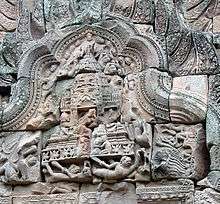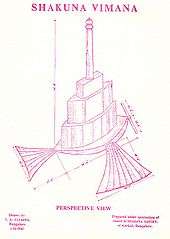Vimana
.jpg)
Vimāna is a mythological flying palace or chariot described in Hindu texts and Sanskrit epics. The Pushpaka Vimana of the demon king Ravana (which was taken from Lord Kubera, and returned to him by Rama) is the most quoted example of a vimana. Vimanas are also mentioned in Jain texts.
Etymology

The Sanskrit word vi-māna (विमान) literally means "measuring out, traversing" or "having been measured out". Monier Monier-Williams defines Vimana as "a car or a chariot of the gods, any mythical self-moving aerial car sometimes serving as a seat or throne, sometimes self-moving and carrying its occupant through the air; other descriptions make the Vimana more like a house or palace, and one kind is said to be seven stories high", and quotes the Pushpaka Vimana of Ravana as an example. It may denote any car or vehicle, especially a bier or a ship as well as a palace of an emperor, especially with seven stories.[1] In some modern Indian languages like Telugu, Hindi, vimana means "aircraft", for example in the town name Vimanapura (a suburb of Bangalore) and Vimannagar, a town in Pune. In another context, Vimana is a feature in Hindu temple architecture.
Vedas

The predecessors of the flying vimanas of the Sanskrit epics are the flying chariots employed by various gods in the Vedas: the Sun (see Sun chariot) and Indra and several other Vedic deities are transported by flying wheeled chariots pulled by animals, usually horses.
The existing Rigveda versions do not mention Vimanas, but verses RV 1.164.47-48 have been taken as evidence for the idea of "mechanical birds":
- 47. kṛṣṇáṃ niyânaṃ hárayaḥ suparṇâ / apó vásānā dívam út patanti
- tá âvavṛtran sádanād ṛtásyâd / íd ghṛténa pṛthivî vy ùdyate
- 48. dvâdaśa pradháyaś cakrám ékaṃ / trîṇi nábhyāni ká u tác ciketa
- tásmin sākáṃ triśatâ ná śaṅkávo / 'rpitâḥ ṣaṣṭír ná calācalâsaḥ
- "Dark the descent: the birds are golden-coloured; up to the heaven they fly robed in the waters.
- Again descend they from the seat of Order, and all the earth is moistened with their fatness."
- "Twelve are the fellies, and the wheel is single; three are the naves. What man hath understood it?
- Therein are set together spokes three hundred and sixty, which in nowise can be loosened." ("trans." Griffith)
Swami Dayananda Saraswati interpreted these verses to mean:
- "jumping into space speedily with a craft using fire and water ... containing twelve stamghas (pillars), one wheel, three machines, 300 pivots, and 60 instruments."[2]
Hindu epics

Ramayana
In the Ramayana, the pushpaka ("flowery") vimana of Ravana is described as follows:
- "The Pushpaka Vimana that resembles the Sun and belongs to my brother was brought by the powerful Ravana; that aerial and excellent Vimana going everywhere at will ... that chariot resembling a bright cloud in the sky ... and the King [Rama] got in, and the excellent chariot at the command of the Raghira, rose up into the higher atmosphere.'"[3]
It is the first flying vimana mentioned in existing Hindu mythology texts (as distinct from the gods' flying horse-drawn chariots). Pushpaka was originally made by Vishwakarma for Brahma, the Hindu god of creation; later Brahma gave it to Kubera, the God of wealth; but it was later stolen, along with Lanka, by his half-brother, king Ravana.
Jain literature
Vimāna-vāsin ('dweller in vimāna') is a class of deities who served the tīrthaṃkara Mahā-vīra.[4] These Vaimānika deities dwell in the Ūrdhva Loka heavens. According to the Kalpa Sūtra of Bhadra-bāhu, the 24th tīrthaṃkara Mahā-vīra himself emerged from the great vimāna Puṣpa-uttara;[5] whereas the 22nd tīrthaṃkara Ariṣṭa-nemi emerged from the great vimāna Aparijita.[6] The tīrthaṃkara-s Abhinandana (4th) and Sumati-nātha (5th) both[7] traveled through the sky in the "Jayanta-vimāna", namely the great vimāna Sarva-artha-siddhi, which was owned by[8] the Jayanta deities; whereas the tīrthaṃkara Dharma-nātha (15th) traveled through the sky in the "Vijaya-vimāna".[9] A vimāna may be seen in a dream, such as the nalinī-gulma.[10][11]
Vaimānika Shāstra

The Vaimānika Shāstra is an early 20th-century Sanskrit text on aeronautics, obtained allegedly by mental channeling, about the construction of vimānas, the "chariots of the Gods". The existence of the text was revealed in 1952 by G. R. Josyer, according to whom it was written by one Pandit Subbaraya Shastry, who dictated it in 1918–1923. A Hindi translation was published in 1959, the Sanskrit text with an English translation in 1973. It has 3000 shlokas in 8 chapters. Subbaraya Shastry allegedly stated that the content was dictated to him by Maharishi Bharadvaja (who is believed to have lived at least 10,000 years ago).[13] A study by aeronautical and mechanical engineering at Indian Institute of Science, Bangalore in 1974 concluded that the aircraft described in the text were "poor concoctions" and that the author showed a complete lack of understanding of aeronautics.[14]
In popular culture
Vimanas have appeared in books, films, internet and games including:
- Grant Morrison's Vimanarama features vimanas.
- Vimana is an arcade game from Toaplan wherein the player's ship earns the name.
- In Noctis, a space exploration game, an interstellar propulsion system called the "Vimana Drive" is used.
- The psy-trance producers Etnica released 'Vimana' in 1997 with samples drawn from the film 'Roswell', which includes references to UFOs and alien life forms.
- Gouryella, a former trance duo, used Vimana as one of their aliases.
- In Fate/Zero, Archer has a vimana in his Gate of Babylon.
- In The Objective, a US Special Forces ODA searches for vimanas in Afghanistan
- In the game Deep Labyrinth, the labyrinth is referred to as Vimana by its caretakers.
- Vimana is briefly referenced in the song "Vi sess utanför" by Swedish hip-hop artist OP.
- There was a Brazilian progressive rock group (1974–1979) called Vímana (stress on the first syllable) that, in spite of achieving little success, is particularly interesting because three of its former members later became music stars in Brazil: Lobão (drummer), Ritchie (bassist), Lulu Santos (guitarist/vocalist). The band also had in its ranks, for two years (1977/1979), Swiss keyboardist Patrick Moraz, then fresh from Yes. They issued one record, in 1976, and disbanded shortly after finishing recording the second.
- Michael Scott (Irish author) wrote The Secrets of the Immortal Nicholas Flamel, a fantasy series that included flying vimanas in the later books.
- In 'Magic Strikes', the third Kate Daniels series Urban Fantasy novel by Ilona Andrews, the climax of the novel takes place on the Pushpaka Vimana.
- The Emperor's Riddles, a 2014 Indian mystery thriller novel by Satyarth Nayak explores the Vimanas of ancient India.
- In the film Children Who Chase Lost Voices the flying arks are referred to as Shakuna Vimanas.
See also
References
- ↑ Monier-Williams, Sanskrit-English Dictionary
- ↑ cited after Mukunda, H.S.; Deshpande, S.M.; Nagendra, H.R.; Prabhu, A.; Govindraju, S.P. (1974). "A critical study of the work "Vyamanika Shastra"" (PDF). Scientific Opinion: 5–12. Retrieved 2007-09-03. p. 5.
- ↑ Dutt, Manatha Nath (translator), Ramayana, Elysium Press, Calcutta, 1892 and New York, 1910.
- ↑ Hermann Jacobi (2008). Jaina Sūtras. p. 169. ISBN 9781605067278.
- ↑ (2) Archived December 8, 2008, at the Wayback Machine.
- ↑ (171) Archived December 8, 2008, at the Wayback Machine.
- ↑ Johann Georg Buhler (ed. by James Burgess) : The Indian Sect of the Jainas. London : Luzac, 1903. p. 67
- ↑ Johann Georg Buhler (ed. by James Burgess) : The Indian Sect of the Jainas. London : Luzac, 1903. p. 74
- ↑ Johann Georg Buhler (ed. by James Burgess) : The Indian Sect of the Jainas. London : Luzac, 1903. p. 69
- ↑ Saryu Doshi (transl. by Thomas Dix) : Dharma Vihara, Ranakpur. Axel Menges, 1995. p. 11a.
- ↑ Mewar Encyclopedia, s.v. "Ranakpur, founding of" Archived July 21, 2011, at the Wayback Machine.
- ↑
- Mukunda, H.S.; Deshpande, S.M.; Nagendra, H.R.; Prabhu, A.; Govindraju, S.P. (1974). "A critical study of the work "Vyamanika Shastra"" (PDF). Scientific Opinion: 5–12. Retrieved 2007-09-03.
- ↑ Childress (1991), p. 109
- ↑ "Flights of fancy? (Part X of XII)". The Week. 2001-06-24. Archived from the original on 2012-03-31. Retrieved 2009-06-29.
External links
- WorldMysteries.com The Anti-Gravity Handbook (Lost Science) by David Hatcher Childress
- Vymanika Shastra
- UFOs and Vimanas
- Los Vimanas (a collection of various texts, partially in Spanish and partially in English) http://www.bibliotecapleyades.net/esp_vimanas.htm#inicio
- "Vimana Aircraft of India: More Sloppy Scholarship from David Childress" by Jason Colavito
